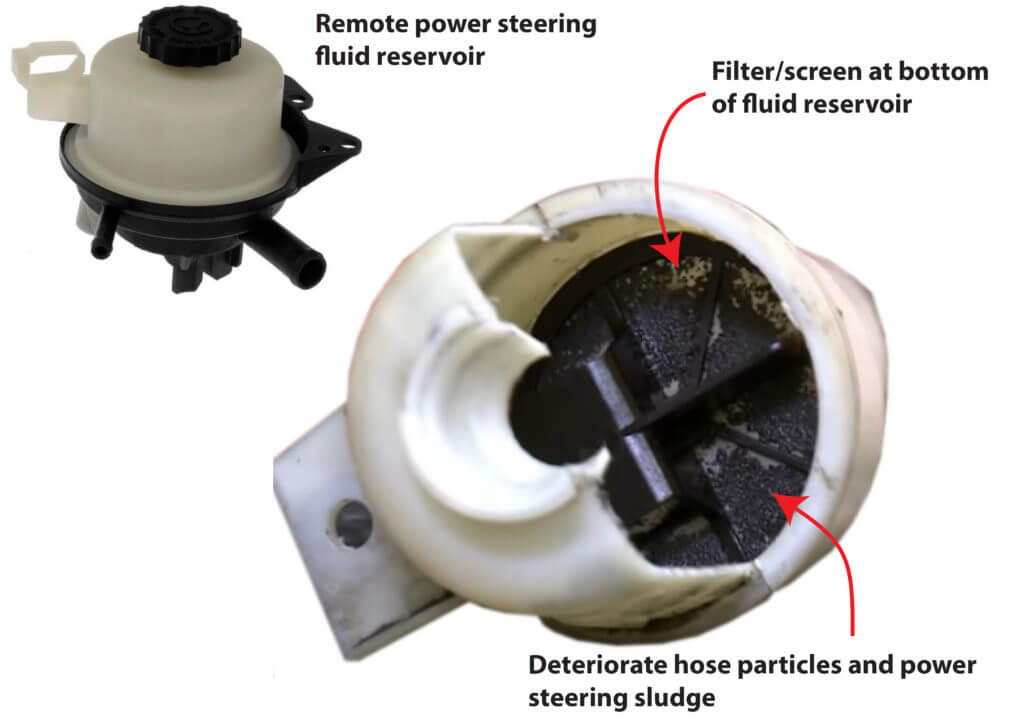How to bleed power steering using a safe procedure
There’s a safer way to bleed power steering that doesn’t risk blowing out the seals
If you do an online search for the proper way to bleed power steering you’ll see the same advice; start the engine and turn the steering wheel lock to lock several times until the moaning sound stops. That is no longer the recommended way to bleed power steering
Bleeding power steering with the engine running while turning lock to lock generates up to 2,000-psi. and can easily blow out seals in the rack or pump or damage the power steering line.
How the damage happens
Power steering gears have a spool valve with a torque rod. When the vehicle’s tires are on the ground, turning the steering wheel lock to lock applies maximum torque to the spool valve, causing it to open the ports to their maximum. That, in turn, makes the pump work harder to deliver maximum volume and pressure to overcome the wheel’s resistance to turning.
If there’s any air in the system or the pump is dry when you do this, the pump can develop serious enough cavitation to destroy the pump vanes and the housing. Air can also seep past seals easier than fluid causing an unnecessary leak.
Chrysler and other carmakers recommended bleeding power steering using a handheld vacuum pump
• Fill the reservoir
• Cover the reservoir with a sealing vacuum disc
• Apply vacuum to the system and hold it for 5-minutes
• Check the fluid level in the reservoir, top up if needed
• Repeat if needed to fully remove all air.
The vacuum method eliminates the possibility of air pockets. It is the safest way to bleed air from the power steering system.
GM recommendation for bleeding power steering
If you don’t have a vacuum pump, try following the GM method
• Raise the wheels off the ground. This is to remove resistance from the tires turning on the floor with the full weight of the vehicle.
• Fill the reservoir
• Turn the steering wheel lock to lock with the ENGINE OFF. This will suck fluid from the reservoir and push excess fluid back through the return how without causing any stress on the power steering pump.
• Then start the engine and complete the lock to lock procedure, but do it S L O W L Y. Turning the wheel quickly overheats the fluid. You may need to cycle the steering wheel up to 20 times.
What else to check when you replace a power steering component
Check power steering hose condition
Power steering hoses don’t last forever and they fail from the inside. If you see any particulate matter in the fluid or on the filtration screen in the reservoir, you’ve got hose deterioration going on and they should both be replaced.
If the old power steering fluid smells burnt, chances are the high heat has also degraded the hoses.
Check the power steering hose crimp areas for signs of leakage. Power steering fluid is highly flammable and it’s hard to extinguish. So replace leaking hoses to prevent power steering pump damage and reduce the threat of fire. Also check for rubbing abrasions, or hose bulges. If you find any, replace the hose.
Clean the power steering fluid reservoir
Some are easy to remove and clean. But others contain a fine screen that can’t be cleaned. If there’s particulate matter embedded in the screen or sludge from deteriorated fluid, replace the entire reservoir.
A plugged reservoir screen will cause fluid starvation and power steering “moan.” This is common on Chrysler vehicles with an internal reservoir screen.
All power steering fluid is not the same
In fact, there’s no such thing as a universal power steering fluid. Use the wrong power steering fluid and you can create leaks! Using the wrong power steering fluid on a Honda can cause rapid shaft wear. Using the wrong power steering fluid on a GM vehicle can cause shaft breakage or seal leaks in cold weather.
Check the belt drive system
Automatic belt tensioner life is about 100,000 miles, or the life of the belt. Installing a new belt on an old belt tensioner is asking for trouble.
© , 2022 Rick Muscoplat
